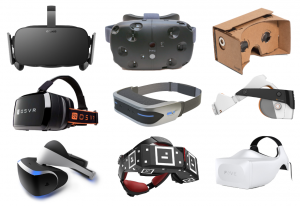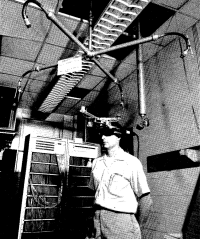Difference between revisions of "Virtual Reality Devices"
m (removed extra space between paragraphs) |
(added some history) |
||
| Line 17: | Line 17: | ||
First experiments with devices, that we could call virtual reality devices, begun in the first half of the 20th century. American film-maker and inventor Morton L. Heilig, in pursuing his goal of construction the ultimate Experience Theatre, constructed multimedia device he called [[Wikipedia:The Sensorama|The Sensorama]].<ref>Heilig, Morton. "The Cinema of the future." Translated by Uri Feldman. In Multimedia: From Wagner to Virtual Reality. Edited by Randall Packer and Ken Jordan. Expanded ed. New York: WW Norton (2002): 239-251.</ref> It was a mechanical device capable of displaying a stereoscopic 3D image, playing stereo sound and tilting the user sitting in front of it in dependence with what what happening on the screen. It was also equipped with an aroma dispenser to convey smells of the environment being displayed. Unfortunately, Heilig did not manage to secure funding for his project and The Sensorama remained a prototype only. | First experiments with devices, that we could call virtual reality devices, begun in the first half of the 20th century. American film-maker and inventor Morton L. Heilig, in pursuing his goal of construction the ultimate Experience Theatre, constructed multimedia device he called [[Wikipedia:The Sensorama|The Sensorama]].<ref>Heilig, Morton. "The Cinema of the future." Translated by Uri Feldman. In Multimedia: From Wagner to Virtual Reality. Edited by Randall Packer and Ken Jordan. Expanded ed. New York: WW Norton (2002): 239-251.</ref> It was a mechanical device capable of displaying a stereoscopic 3D image, playing stereo sound and tilting the user sitting in front of it in dependence with what what happening on the screen. It was also equipped with an aroma dispenser to convey smells of the environment being displayed. Unfortunately, Heilig did not manage to secure funding for his project and The Sensorama remained a prototype only. | ||
[[File:Sword of damocles vr.png|200px|thumbnail|left|The Sword of Damocles device with its mechanical head tracking sensors in place.]] | [[File:Sword of damocles vr.png|200px|thumbnail|left|The Sword of Damocles device with its mechanical head tracking sensors in place.]] | ||
| − | While certainly a device capable of virtual reality, The Sensorama was purely mechanical in nature. The true virtual reality machine, one that displays a computer-generated environment, was called The Sword of Damocles.<ref name="sutherland68">SUTHERLAND, Ivan E. A head-mounted three dimensional display. In: Proceedings of the December 9-11, 1968, fall joint computer conference, part I. ACM, 1968. p. 757-764.</ref> The name was fitting, because the device was quite bulky and had to be attached to a mechanical arm on the ceiling. It was constructed by a computer scientist and computer graphics pioneer [[Wikipedia:Ivan Sutherland|Ivan E. Sutherland]] and his student Bob Sproull in 1968. At that time, they both worked at the [[Wikipedia:Massachusetts Institute of Technology|Massachusetts Institute of Technology]] and the experiments with their [[:Category:Head Mounted Displays|Head Mounted Display]] are believed to be the first of the kind. The displayed graphics comprised of simple | + | While certainly a device capable of virtual reality, The Sensorama was purely mechanical in nature. The true virtual reality machine, one that displays a computer-generated environment, was called The Sword of Damocles.<ref name="sutherland68">SUTHERLAND, Ivan E. A head-mounted three dimensional display. In: Proceedings of the December 9-11, 1968, fall joint computer conference, part I. ACM, 1968. p. 757-764.</ref> The name was fitting, because the device was quite bulky and had to be attached to a mechanical arm on the ceiling. It was constructed by a computer scientist and computer graphics pioneer [[Wikipedia:Ivan Sutherland|Ivan E. Sutherland]] and his student Bob Sproull in 1968. At that time, they both worked at the [[Wikipedia:Massachusetts Institute of Technology|Massachusetts Institute of Technology]] and the experiments with their [[:Category:Head Mounted Displays|Head Mounted Display]] are believed to be the first of the kind. The displayed graphics comprised of simple wire-frame rooms and offered mechanical head tracking. |
| + | |||
| + | MIT continued leading the VR research and in 1977 introduced the ARPA funded multimedia system Aspen Movie Map. Essentially an interactive video recorded with four car-mounted cameras, the resulting virtual environment of the Aspen city in Colorado could be navigated in a way similar to Google Street View today. The user could choose an arbitrary path through the virtual city and because Aspen was filmed twice, early fall and winter, the viewer was able to change the season on demand. | ||
| + | |||
Revision as of 10:28, 3 September 2015
List of Virtual Reality Devices:
- 3dHEAD GCS3
- Altergaze
- AntVR
- Archos VR
- Avegant Glyph
- Beenoculus
- Cmoar
- Durovis Dive 5
- Durovis Dive 7
- FOVE
- GameFace
- Goggle Tech Go4D C1-Glass
- Goggle Tech Go4D VR
- Google Cardboard
- Homido
- HTC Vive
- Merge VR
- MindLeap
- Oculus Rift
- OSVR
- Project Morpheus
- Samsung Gear VR
- Sensics dSight
- Silicon Micro Display ST1080
- StarVR
- Sting Virtua
- Sulon Cortex
- Virtual Reality Devices
- VisusVR
- VrAse
- Vrvana Totem
- Xingear VR
- XiONVR Go
- Zeiss VR ONE
Virtual Reality Devices are a type of Wearable devices that are worn on the head and display information directly into user's eyes through one or more electronic displays present in the device. Together with Smartglasses and Smart Contact Lenses they create the Head Mounted Displays category. The virtual reality feeling is achieved by splitting the image, or using two displays, of the displayed information in such a way, that a stereoscopic view is created. This creates the feeling of depth in what the user sees and strengthens the immersion of the virtual reality. Additionally, other means of increasing the immersion are often present. These can include sensors to register the position and tilt of the device, which can be then carried over to the virtual reality, headphones to play sound and or music, or eye- and hands-tracking technologies.
Unlike Smartglasses, Virtual Reality Devices are fully enclosed and, with the exception of some hybrid devices combining both, they are not see-through and thus do not combine the actual and virtual realities together. The reality is not altered, but it is completely blocked out instead.
Historical overview
First experiments with devices, that we could call virtual reality devices, begun in the first half of the 20th century. American film-maker and inventor Morton L. Heilig, in pursuing his goal of construction the ultimate Experience Theatre, constructed multimedia device he called The Sensorama.[1] It was a mechanical device capable of displaying a stereoscopic 3D image, playing stereo sound and tilting the user sitting in front of it in dependence with what what happening on the screen. It was also equipped with an aroma dispenser to convey smells of the environment being displayed. Unfortunately, Heilig did not manage to secure funding for his project and The Sensorama remained a prototype only.
While certainly a device capable of virtual reality, The Sensorama was purely mechanical in nature. The true virtual reality machine, one that displays a computer-generated environment, was called The Sword of Damocles.[2] The name was fitting, because the device was quite bulky and had to be attached to a mechanical arm on the ceiling. It was constructed by a computer scientist and computer graphics pioneer Ivan E. Sutherland and his student Bob Sproull in 1968. At that time, they both worked at the Massachusetts Institute of Technology and the experiments with their Head Mounted Display are believed to be the first of the kind. The displayed graphics comprised of simple wire-frame rooms and offered mechanical head tracking.
MIT continued leading the VR research and in 1977 introduced the ARPA funded multimedia system Aspen Movie Map. Essentially an interactive video recorded with four car-mounted cameras, the resulting virtual environment of the Aspen city in Colorado could be navigated in a way similar to Google Street View today. The user could choose an arbitrary path through the virtual city and because Aspen was filmed twice, early fall and winter, the viewer was able to change the season on demand.
Summary of technical aspects
Use
VR devices are used in education, military training, therapy and entertainment.
References
- ↑ Heilig, Morton. "The Cinema of the future." Translated by Uri Feldman. In Multimedia: From Wagner to Virtual Reality. Edited by Randall Packer and Ken Jordan. Expanded ed. New York: WW Norton (2002): 239-251.
- ↑ SUTHERLAND, Ivan E. A head-mounted three dimensional display. In: Proceedings of the December 9-11, 1968, fall joint computer conference, part I. ACM, 1968. p. 757-764.

